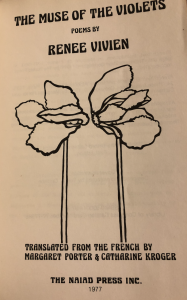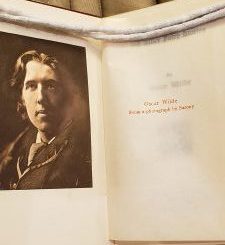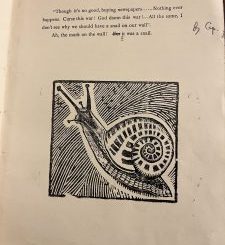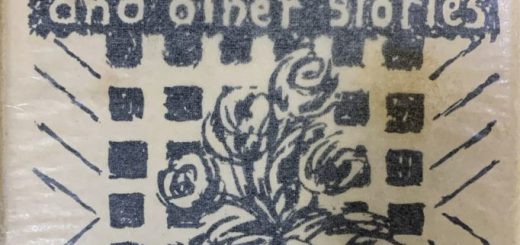Violets and Dramatics: A Look at Renée Vivien’s The Muse of the Violets by Maddie S.
 Renee Vivien’s The Muse of the Violets is a collection of poetry translated from its original French. It is a small, thin book, a first edition in English published by The Naiad Press published in 1977. An introduction excerpted from a biography about Vivien’s life, written by Louise Faure-Favier, is also included in the publication. Faure-Favier’s account offers readers a fuller picture of who Vivien was and how she was perceived by others, which was most interesting to me in providing context for Vivien’s work. From Faure-Favier’s descriptions, it becomes apparent that Renee Vivien (born Pauline Tarn, but she adopted the epithet in hopes of being perceived as more French) is a dramatic, luxurious woman overly concerned with image and entirely devoted to pleasure. This image-centric lifestyle seems to have fed into her anorexia and drug/alcohol abuse. Described as “incapable of facing life’s common wounds,” Vivien is painted as a dramatique, as she poses her attempted suicide carefully, stretching herself on a divan and resting violets over her chest for the drama of it all.
Renee Vivien’s The Muse of the Violets is a collection of poetry translated from its original French. It is a small, thin book, a first edition in English published by The Naiad Press published in 1977. An introduction excerpted from a biography about Vivien’s life, written by Louise Faure-Favier, is also included in the publication. Faure-Favier’s account offers readers a fuller picture of who Vivien was and how she was perceived by others, which was most interesting to me in providing context for Vivien’s work. From Faure-Favier’s descriptions, it becomes apparent that Renee Vivien (born Pauline Tarn, but she adopted the epithet in hopes of being perceived as more French) is a dramatic, luxurious woman overly concerned with image and entirely devoted to pleasure. This image-centric lifestyle seems to have fed into her anorexia and drug/alcohol abuse. Described as “incapable of facing life’s common wounds,” Vivien is painted as a dramatique, as she poses her attempted suicide carefully, stretching herself on a divan and resting violets over her chest for the drama of it all.
The foreword and title also suggest the importance of violets in Viviens life. This flower and its importance is twofold: on one hand, it stands for Vivien’s deceased friend/possible lover “Violet.” On the other hand, violets are lesbian Greek poet Sappho’s signature. Though Vivien would light incense and make violet offerings to a statue of Sappho’s likeness, Vivien claims the statue is in fact not Sappho, but her friend/lover Violet. This attitude seems in line with the “repressed love” vibe of her poetry.
To me, Vivien’s poetry felt very thematic and repetitive, almost as if one could input words like “Life, death, flowers, emotion, the sea, algae, moon, blonde, pale, gloom,  dream, eyes, sleep” and an AI generator would return a Vivien poem. On brand with Vivien’s dramatic tendencies, her poems are very feeling-focused, incorporate extremes of emotions, and frequently utilize the pronoun “you” in her passionate love poems. I’ve included a picture of her poem “Chanson,” which to me exemplifies Vivien’s poetic and thematic style.
dream, eyes, sleep” and an AI generator would return a Vivien poem. On brand with Vivien’s dramatic tendencies, her poems are very feeling-focused, incorporate extremes of emotions, and frequently utilize the pronoun “you” in her passionate love poems. I’ve included a picture of her poem “Chanson,” which to me exemplifies Vivien’s poetic and thematic style.
The target audience of Vivien’s work is explicit in her poem entitled “You For Whom I Wrote,” where she indicates young lesbian women are her target audience. Translator Porter confirms that this poem intends reader audience rather than a specific lover, as Porter dedicates her translation “To You for whom She wrote, so that more of you will remember her.” This brings into question whether this intended audience applies to only her poetry or to her works more generally. From Porter’s dedication, the poem “You for Whom I Wrote,” and the nature of Vivien’s poetry suggests that her target audience is lesbians and that she writes for representation. But does this audience specification apply to Vivien’s other works like “Prince Charming,” or just her poetry?
“Prince Charming” is a fairy tale-esque story that turns the “prince charming” trope on its head through a non-heteronomative love story, where two women who grew up together flourish together romantically. In the story, female protagonist Sarlota grows up believing she will marry a feminine male of a neighboring family. After this “feminine male” returns after being away, Sarlota falls in love with “him,” who ends up being a masculine woman. Its opening is framed as addressed to a woman, from a woman. This woman for whom the story is written might parallel the woman for whom Vivien’s poetry is written. One could argue “Prince Charming” is only written for lesbians and is meant only for lesbians to see themselves reflected in a non-heternormative love story, but others might argue that this non-heteronormative love story is meant to be an example not only for lesbians, but for the general population. In my view, stories of representation benefit both the population being represented and the general population. However, I think stories of representation are created primarily for the population that is being represented, as the stories are generally crafted with them in mind so as to insert their identities into the mainstream, with them being the first thought and primary motivator for writing.










Recent Comments